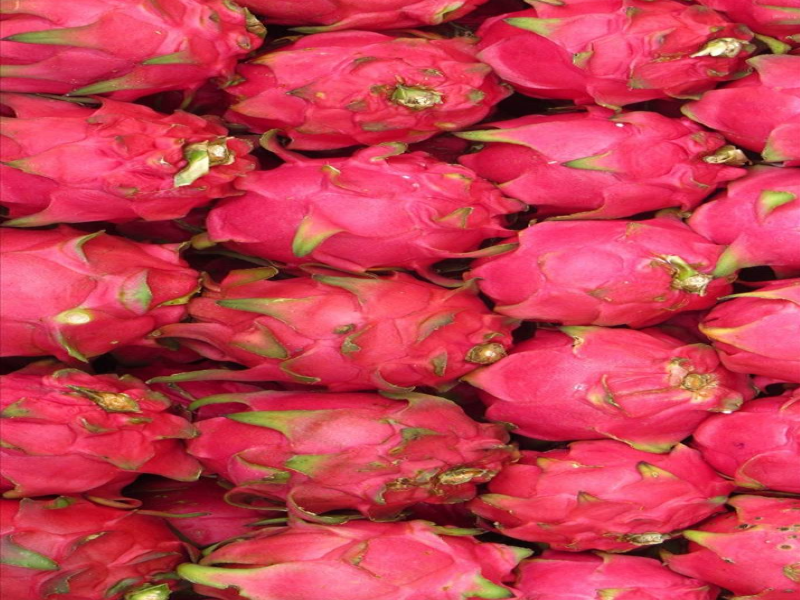
The Dragon Fruit Tree belongs to the family of Cactacea, and is basically a cactus vine of the genus Hylocereus. Originally cultivated in Central Americas, but now it is grown all over the world especially in the tropical countries. It is a fast-growing vine which requires a vertical pole support to grow on and then a ring to fall like an umbrella. Total life span of a Dragon Fruit tree is 15-20 years, and therefore it becomes imported for proper selection of poles & rings. Special RCC poles are casted to ensure a strong & lasting support. Normally four plants per pole are planted in order to maximize the yield. Proper Pole to Pole and Row to Row spacing is maintained for free movement during harvesting and maintenance work. Basic nutrients & fertilizers are periodically applied as per the soil & water properties of each individual plantation. No Metal framing is to be done because it may damage the plant from sun/heat burns. Regions where summer temperatures rise above 40 degrees, the North-South rows are preferred in tropical climates. The growing season of this plant takes place during the summer months. It will not grow the rest of the year, but when it does grow, it grows rapidly. Blooms will occur from July to October, but they will only bloom for one night each year. After the flowering occurs, fruit will begin to form. Common diseases associated with this plant are root rot, sunburn, bird attacks etc . These diseases are easy to control. No major diseases affect this plant actually.
Cultivation & Demand Scenario of India
Farmers in the Sates of Maharashtra, Gujarat, Andhra Pradesh, Karnataka & Tamil Nadu have taken up Dragon fruit cultivation in recent years and domestic cultivation is getting encouragement because of the advantages (mentioned above). The total All India area of Dragon Fruit cultivation has the scope to expand further – currently it is grown in 100 acres approximately. The fruit of the plant has a good taste hence demand is quite healthy for the product. In India Dragon fruit demand remains high mainly due to its taste, in addition to nutritional and medicinal properties. India imports 95% of its requirement from Thailand, Malaysia, Vietnam and Sri Lanka. This fruit also has a great potential for exporting to countries of Gulf, European Union and USA. Most of the imported supply is from Vietnam.
Climate & Irrigation Requirements
Dragon fruit adapts properly to tropical climates and India is a tropical country with moderate climate all round the year. Therefore climatic conditions are favorable for growing the plant amid minor adjustments during extreme temperatures. Dragon fruit belongs to the cactus family (Cactaceae) therefore requires very less water as compared to other crops/fruits. The plant has the capacity to survive for months without water. For Dragon fruit, scientists recommend Drip irrigation as the best method of Irrigation. The plant ideally requires approximately 1 to 2 litres of water per day during the summer/dry days.
Dragonfruit economics
Normally, fruits formation in Dragon fruit begins, 18-26 months after plantation. The plants are grown in cemented poles normally as they need support to maintain erect position. Poles are generally cemented so as to provide longevity and minimize any damage of the plant. In one acre, there are 300 poles roughly and one pole generally yields around 15 to 25 kg of fruits. Practically it has been observed that Yield of 60/80 kgs per pole is possible. Rates for the fruits fetch the market for Rs.300 to 400 per kg. The general Farm rate is between Rs. 125 to 200 per kg. These data are for a well maintained farm. It may be noted that if Night Lighting method is also done then is can increased quantity of fruits. Therefore the calculation will work as:

One Acre x 300 poles x 15 kg x Rs.125 = Rs. 5.63 Lakhs per Acre per Year approximately
Please note that all the numbers have been taken on the lowest (minimum) side
The average yield is 5–6 tonne per acre while market price is around Rs. 200/ per kg. Cost in to be incurred for the poles, rings, cow dung, and fertilizer in every 4 months. Then there are labour cost in addition to expenses for pruning and irrigation (preferably drip irrigation) and also of netting for shielding the plant from birds. The recurring cost has been worked out around Rs 80,000 to One Lakh per tonne, by successful growers. A fixed cost of pole, ring, and drip irrigation is to be considered and the average expense for these is nearly Rs 25,000/ per tonne. It takes 18-26 months 1.5- 2 years) for harvesting, and between months of August to December. Therefore deducting all expenses net profit comes closer to Rs 4.50 lacs per acre over first 2 years.
Advantages of growing & selling dragonfruit
There are lots of advantages regarding its cultivation as well as doing business. Firstly, it grows in any type of soil. Secondly the plant requires minimum maintenance as well as water intake. Thirdly Dragon Fruit has the ability to tolerate the climatic conditions of India. Another advantage is that commercially one can expect returns 2nd or 3rd year after planting. Not many business ventures start giving returns so early. The cuttings of the plant can be re-used for selling or further propagation. There is generally good demand for the product in global and international markets. Disease control is easy as no major disease problems are associated with this plant. Therefore growing this plant is economically viable. Last but not the least, sale from value added products of Dragon fruit gives even better rates than normal sale of the Dragon fruit.
A proper maintained farm can support dragon fruit trees for a long duration of 15-20 Years. Surely production in dragon fruit can be carried out with lesser challenges and doing business is economically feasible in India.
















